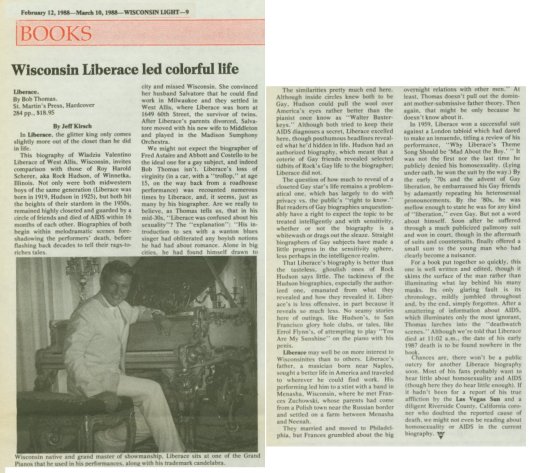|

|
|||||||
|
Liberace was born Wladziu Valentino Liberace at 1649 60th Street, in West Allis, Wisconsin, on May 16, 1919, the survivor of twins. There was music in the family; Liberace's father and some siblings were also in the music industry. There are rumors that some of Liberace's first performances were in Milwaukee's gay establishments, although this is unconfirmed to date. But he was an extremely talented pianist with a special flair, and quickly became in demand both locally and then nationally. He became a national icon, the highest paid pianist ever, and was known around the world as "Mr. Showmanship". Brief History (condensed from the Liberace Foundation for the Performing and Creative Arts website): For decades, Liberace was known for his music, candelabra, charisma, diamonds and dazzle. Liberace transported audiences to a dazzling world of color, joyful music, glittering costumes, and humor. Liberace had fun with his costumes, cars and homes. Over the years Liberace acquired an astounding array of prestigious awards, including: Instrumentalist of the Year, Best Dressed Entertainer and Entertainer of the Year. He also earned two Emmy Awards, six gold albums, two stars on the Hollywood Walk of Fame. He is listed in the Guinness Book of World Records as the world's highest paid musician and pianist. Best of all, he was known and loved throughout the world as "Mr. Showmanship." In 1940, his night club dates took him to the Persian Room in New York's Plaza Hotel as an intermission pianist. Seven years later, he returned with his own oversized grand piano and his first trademark, a glittering candelabra. Acting on Paderewski's early advice, Liberace dropped his first two names, opting to use "Liberace" exclusively. In 1950, he made his first film debut as honky tonk pianist in the movie "South Sea Sinner," with Shelley Winters. A little later, while playing a club date at the San Diego Coronado Hotel, he was discovered by a television producer. A local Los Angeles television show was created. A national television series debuted in 1952. Liberace turned to daytime television in 1960, with a series on ABC. For three years, 1976 - 1979, Liberace was acclaimed "Pop Keyboard Artist of the Year" by Contemporary Keyboard Magazine. Liberace returned to television in 1978 with his first American TV special for CBS, followed by a second in February 1979. In 1977 Liberace founded the non-profit Liberace Foundation for the Performing and Creative Arts. Liberace considered the Foundation, which funds scholarships for schools and colleges across the nation, as one of his greatest achievements. On April 15, 1979, Liberace opened The Liberace Museum in Las Vegas, Nevada. The Museum serves as the key funding arm for the Foundation. In 1980, Las Vegas named him both Star of the Year and Entertainment Personality of the Year. In 1981, Pacific Pioneer Broadcasters presented him with its coveted "Golden Mike" award. In 1982, he was voted to the Keyboard Magazine Hall of Fame by the publications' readers. Also in 1982, Liberace made a special showcase appearance at the Academy Awards, performing all five nominated film themes. In the spring of 1984 Liberace's premier engagement at New York's famed Radio City Music Hall broke all sales and attendance records of the 51-year history of the Art Deco palace. More than 80,000 people were on hand for what Liberace described as "the fulfillment of a dream and the culmination of my 40 years in show business." Commenting on the engagement, The Wall Street Journal said: "Liberace occupies his own special rhinestone-studded niche in the American dream." Liberace's final performances were at Radio City Music Hall October 16 through November 2, 1986. After his Radio City engagement he went on a four-city-tour to promote his fourth book, "The Wonderful Private World of Liberace." Then he returned to his Palm Springs home where he passed away on February 4, 1987, just a few months before his 68th birthday. Liberace's death was later reported to have been of complications from AIDS. It has been observed that Liberace's life invites comparison with that of Roy Harold Scherer, known as Rock Hudson. Both were midwestern boys of the same generation (Hudson was born in 1925 in Winnetka, Illinois), hit their heights of stardom in the 1950s, remained highly closeted and closely guarded by a circle of friends, and died of AIDS within 16 months of each other. Learn more about Liberace at the Liberace Foundation for the Performing and Creative Arts website. |
 Typical photo of Liberace  New book, "Liberace", 1988, by Bob Thomas (St. Martin's Press) |
Credits: information from Wisconsin Light articles<
and the Liberace Foundation for the Performing and Creative Arts;
Last updated: 10-August-2005.